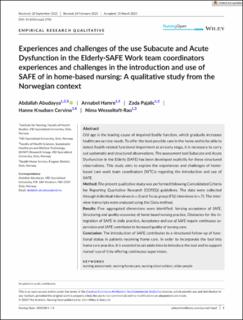| dc.contributor.author | Abudayya, Abdallah | |
| dc.contributor.author | Hamre, Annabel | |
| dc.contributor.author | Pajalic, Zada | |
| dc.contributor.author | Cervino, Hanne | |
| dc.contributor.author | Neolene Wesseltoft-Rao, Nima | |
| dc.date.accessioned | 2023-04-24T13:05:33Z | |
| dc.date.available | 2023-04-24T13:05:33Z | |
| dc.date.created | 2023-03-16T12:35:40Z | |
| dc.date.issued | 2023 | |
| dc.identifier.citation | Nursing Open. 2023, 1-11 | en_US |
| dc.identifier.issn | 2054-1058 | |
| dc.identifier.uri | https://hdl.handle.net/11250/3064542 | |
| dc.description | This is an open access article under the terms of the Creative Commons Attribution-NonCommercial-NoDerivs License, which permits use and distribution in any medium, provided the original work is properly cited, the use is non-commercial and no modifications or adaptations are made. | en_US |
| dc.description.abstract | Old age is the leading cause of impaired bodily function, which gradually increases healthcare service needs. To offer the best possible care in the home and to be able to detect health-related functional impairment at an early stage, it is necessary to carry out systematic and structured observations. The assessment tool Subacute and Acute Dysfunction in the Elderly (SAFE) has been developed explicitly for these structured observations. This study aims to explore the experiences and challenges of homebased care work team coordinators (WTCs) regarding the introduction and use of SAFE.
Method: The present qualitative study was performed following Consolidated Criteria for Reporting Qualitative Research (COREQ) guidelines. The data were collected through individual interviews (n= 3) and focus group (FG) interviews (n= 7). The interview transcripts were analysed using the Gioia method.
Results: Five aggregated dimensions were identified: Varying acceptance of SAFE, Structuring and quality-assurance of home-based nursing practice, Obstacles for the integration of SAFE in daily practice, Acceptance and use of SAFE require continuous supervision and SAFE contributes to increased quality of nursing care.
Conclusion: The introduction of SAFE contributes to a structured follow-up of functional status in patients receiving home care. In order to incorporate the tool into home care practice, it is essential to set aside time to introduce the tool and to support nurses' use of it by offering continuous supervision. | en_US |
| dc.language.iso | eng | en_US |
| dc.publisher | John Wiley & Sons | en_US |
| dc.rights | Attribution-NonCommercial-NoDerivatives 4.0 Internasjonal | * |
| dc.rights.uri | http://creativecommons.org/licenses/by-nc-nd/4.0/deed.no | * |
| dc.subject | older people | en_US |
| dc.subject | nursing observations | en_US |
| dc.subject | nursing home care | en_US |
| dc.subject | nursing assessment | en_US |
| dc.title | Experiences and challenges of the use Subacute and Acute Dysfunction in the Elderly-SAFE | en_US |
| dc.type | Peer reviewed | en_US |
| dc.type | Journal article | en_US |
| dc.description.version | publishedVersion | en_US |
| dc.rights.holder | © 2023 The Authors. Nursing Open published by John Wiley & Sons Ltd. | en_US |
| dc.source.pagenumber | 1-11 | en_US |
| dc.source.journal | Nursing Open | en_US |
| dc.identifier.doi | https://doi.org/10.1002/nop2.1732 | |
| dc.identifier.cristin | 2134424 | |
| cristin.ispublished | true | |
| cristin.fulltext | original | |
| cristin.qualitycode | 1 | |

